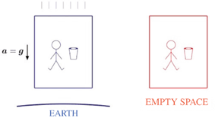Abstract
The structure of the Lorentz transformation depends intimately on the conventional operations for measurement of lengths (L) and time intervals (T). The prescription for length measurement leads to justifiable utilization of Euclidean geometry over finite values of the coordinates. Then T-values can be regarded as ratios of length measurements within a suitably defined clock. In certain cases the synchronization process should be supplemented by measurements providing position certification. The Lorentz transformation emerges from three specific symmetry statements, assured by the nature of the L and T operations: (1) one-one correspondence of finite values of the coordinates of two inertial frames, (2) frame reciprocity, and (3) spatial isotropy. (Light signaling is not needed in this derivation. Afterward, it is assumed that light is indeed an agent moving with the common speed revealed by the transformation.) When rest masses have been determined in the conventional fashion, the conservation of momentum and of energy follow from the kinematics—a result due to Einstein.
Similar content being viewed by others
References
P. Frank and H. Rothe,Ann. Physik 34, 835 (1911); A. Church,Am. Math. Monthly 31, 376 (1924); H. Arzelies,Relativity Kinematics (Pergamon, Oxford, 1966); A. Grünbaum,Am. J. Phys. 23, 450 (1955) and24, 588 (1956); B. Liebowitz,Am. J. Phys. 24, 597 (1956).
Banesh Hoffmann,Rev. Mod. Phys. 4, 173 (1932); S. Basri,Rev. Mod. Phys. 37, 288 (1965).
A. Einstein,Ann. Physik 17, 891 (1905) [transl. by Perrott and Jeffery, inThe Principle of Relativity (Dover, New York, 1952)].
A. N. Whitehead,The Concept of Nature (Cambridge U. P., London, 1964), Chapter 7.
A. N. Whitehead,An Enquiry Concerning the Principles of Natural Knowledge (Cambridge U. P., London, 1925).
F. Klein,Geometry (Dover, New York, 1948), pp. 91, 159–172.
A. N. Whitehead, inEncyclopedia Brittanica, 13th ed. (Encyclopedia Brittanica, Chicago, 1926), Vol. 11, p. 734.
E. T. Bell,The Development of Mathematics, 2nd ed. (McGraw-Hill, New York, 1945), pp. 345–353.
A. Einstein,Relativity, The Special and the General Theory (Crown Publishers, New York, 1951).
A. E. Ruark,How to Understand Special Relativity, Report TID 23694 (U. S. Atomic Energy Commission, September 1966).
A. Einstein,The Meaning of Relativity (Princeton U.P., Princeton, New Jersey, 1923), p. 31.
J. Terrell,Los Alamos Report LADC 2842, April 1957;Bull. Am. Phys. Soc. 4, 294 (1959);Phys. Rev. 116, 1041 (1959);Nuovo Cim. X,16, 457 (1960).
A. E. Ruark,Phys. Rev. 37, 315 (1931).
A. Einstein,Bull. Am. Math. Monthly 41(4) 223 (1935).
A. E. Ruark, A note on classical fields, inIsotopic and Cosmic Chemistry (North-Holland, Amsterdam, 1964), p. 552.
W. S. N. Trimmer, H. F. Baierlein, J. E. Faller, and H. A. Hill,Phys. Rev. D 8, 3321 (1973); W. S. N. Trimmer and H. F. Baierlein,Phys. Rev. D 8, 3326 (1973).
V. Berzi and V. Gorini,J. Math. Phys. 10, 1518 (1969).
V. Gorini and A. Zecca,J. Math. Phys. 11, 2226 (1970).
V. Gorini, inProc. Internat. Study Institute in Math. Phys. (Istanbul, 1970).
V. Gorini,Commun. Math. Phys. 21, 150 (1971).
L. A. Lugiato and V. Gorini, Report CPT-125, December 1971, Center for Particle Theory, Univ. of Texas, Austin, Texas.
H. W. Turnbull,The Theory of Determinants, Matrices and Invariants, 2nd ed. (Blackie and Sons, London, 1945), pp. 155–160, 331, 347–9.
P. A. M. Dirac,Rev. Mod. Phys. 34, 592 (1962).
Author information
Authors and Affiliations
Rights and permissions
About this article
Cite this article
Ruark, A.E. The physical rationale for special relativity. Found Phys 5, 21–36 (1975). https://doi.org/10.1007/BF01100312
Received:
Issue Date:
DOI: https://doi.org/10.1007/BF01100312




